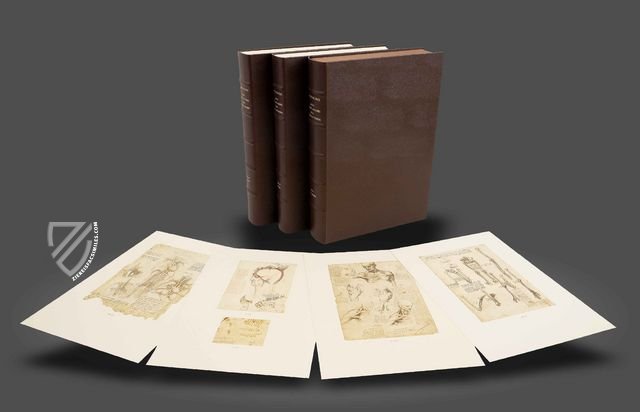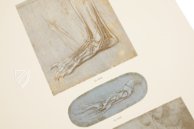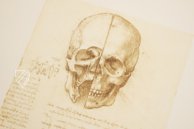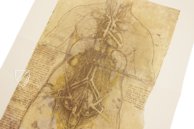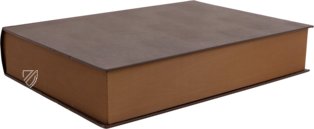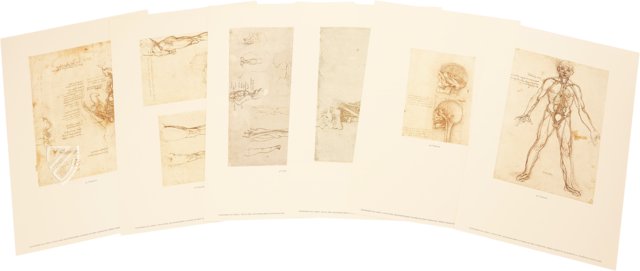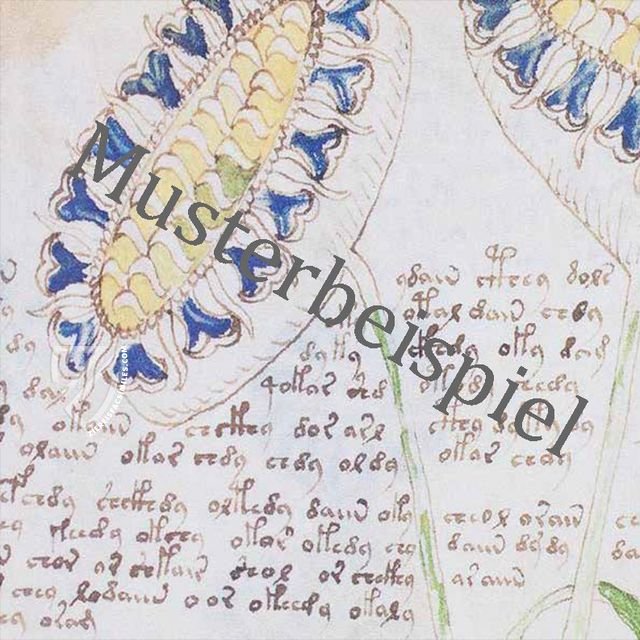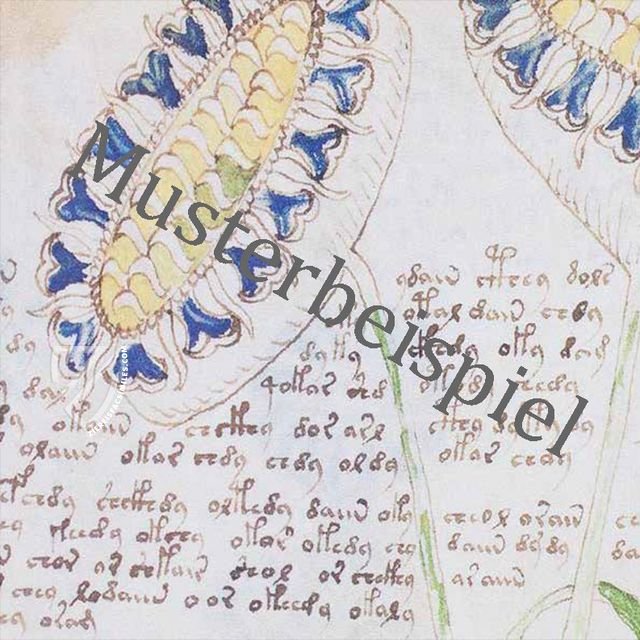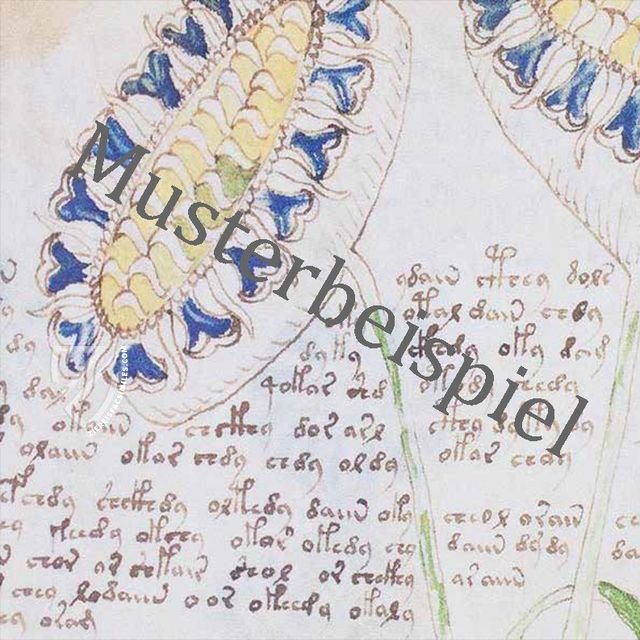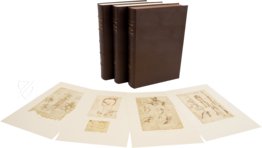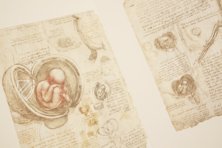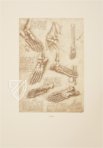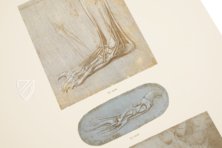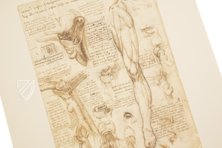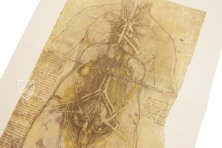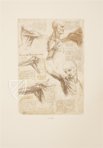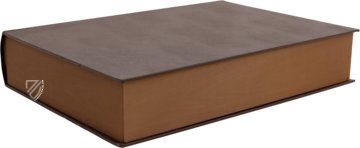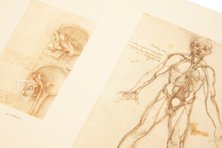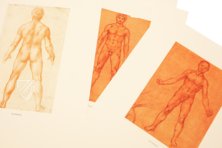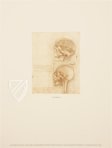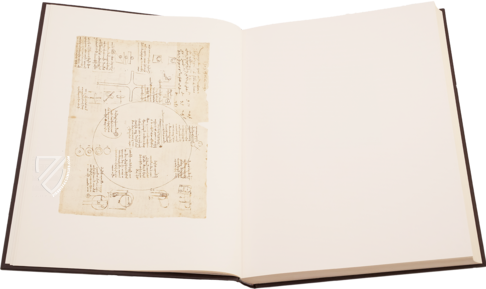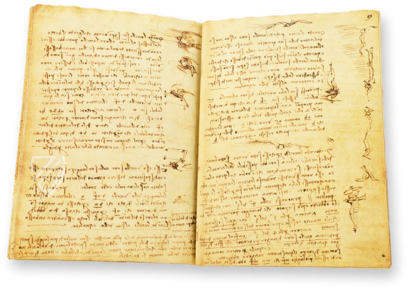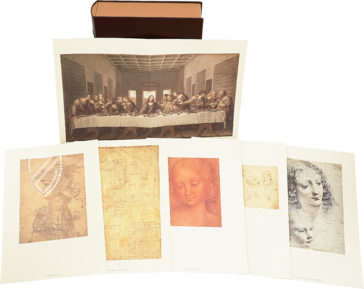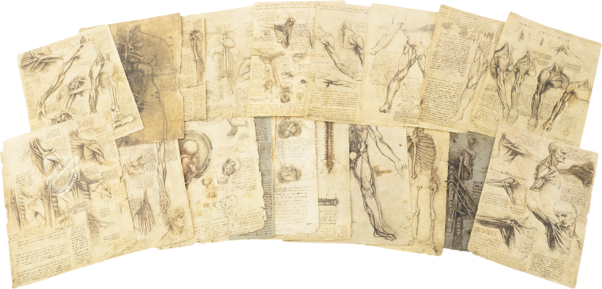Corpus of the Anatomical Studies
(3,000€ - 7,000€)
Leonardo da Vinci (1452-1519) was a passionate researcher of the human body, its structure and its functionality, whereby his interest was fueled by both his scientific curiosity and his artistic perspective. His entire oeuvre is permeated by this theme, and countless masterful drawings still shed light on this intense passion of the famous polymath. The present compendium brings together 400 masterful drawings from the years 1483 to 1513, which are today preserved in the Royal Library in Windsor Castle, including fascinating preliminary studies for the Virgin of the Rocks and his legendary Last Supper, as well as full-body depictions of a human with a glimpse of the inside of the body and accurate studies of individual body parts. This single leaf collection shows in chronological order the development of Leonardo's interest in anatomy, from morphological to physiological studies, and thus provides a unique insight into his genius work.
Corpus of the Anatomical Studies
The study of a hand with its tendons and bones, the state of an unborn fetus in the womb of the mother, the allocation of organs in the human abdomen or a male body with the fascinating play of muscles under the skin: all of that and more were themes that Leonardo da Vinci (1452–1519) studied and recorded in numerous masterful drawings. These findings fascinated the universal genius from both a naturalistic and artistic perspective, helping him on the other hand by developing the human body in his masterful sculptures and paintings.
An Important Aspect of the Masterwork
A grandiose bundle of anatomical studies can be found in Windsor Castle’s impressive collection of Leonardo drawings. 400 drawings from a 30 year period – from 1483 to 1513 – were chosen for the selection at hand. Arranged chronologically, the sheets allow one to understand the development of the drawings from morphological to physiological studies and simultaneously give a wonderful overview of Leonardo’s graphic works.
The Human Body as a Whole and in Detail
Alongside the famous full-body depictions of a human with a glimpse of the inside of the body, with the routes of the blood vessels, the layout of the organs, the construction of the skeleton, and the interplay of the bones are treated in numerous depictions of individual parts of the body as well – e.g. the head or the foot. Thus, for example, one finds a study sheet of the hand in the bundle, which is covered all over with notes and drawings, which wonderfully emphasizes Leonardo’s passion with this work. With accurate, almost medical precision, the universal genius pursued systematic studies of the human body, which are presented in the collection at hand. The bundle of anatomical studies was appended with preliminary studies of the Virgin of the Rocks and The Last Supper, a few landscapes, caricatures, and other figurative representations.
Codicology
- Alternative Titles
- Il Corpus degli Studi Anatomici
Korpus der anatomischen Studien
Leonardo da Vinci - Anatomische Studien - Type
- Manuscript on paper
- Size / Format
- 400 pages / 48.0 × 33.0 cm
- Origin
- Italy
- Date
- 1483–1513
- Epochs
- Style
- Language
- Illustrations
- 400 drawings
- Artist / School
- Leonardo da Vinci (1452–1519)
Corpus of the Anatomical Studies
The Anatomy of a Bear's Foot ca. 1488–90
Bears were still common in the mountains of Italy during the late 15th century and were both hunted for sport as well as kept in captivity for entertainment. Like humans, bears also have a plantigrade gait, meaning that they walk with their feet flat on the ground. Da Vinci’s study of the skeletal structure, musculature, and tendons of the lower leg and foot of a bear would also yield insights concerning the anatomy of the human foot, specimens of which were considerably harder to obtain.

Corpus of the Anatomical Studies
The Major Organs and Vessels ca. 1485–90
This drawing of a man standing with his legs apart and arms extended outward reveals Leonardo’s understanding of the major organs and vessels before he had the opportunity to participate in any substantial human dissection. It is a fusion of two typical medieval anatomical images: the “situs figure” showing the position of organs and the “bloodletting figure” showing the paths of vessels.
Although the colors are now somewhat faded, brown was used for the veins while the arteries were painted green. The figure is depicted as a living man rather than a cadaver and Da Vinci has given him a detailed face that is probably an accurate portrait of the model. This effect is completed by simultaneously showing the outer musculature as well as the internal organs

#1 Il Corpus degli Studi Anatomici
Languages: English or German
(3,000€ - 7,000€)
#2 Leonardo da Vinci: Atlas der anatomischen Studien
Languages: English or German
(3,000€ - 7,000€)
#3 Leonardo da Vinci: Corpus of the anatomical studies in the collection of Her Majesty the Queen at Windsor Castle (English Edition)
Language: English
(3,000€ - 7,000€)
#4 Anatomia I
Language: Italian
(1,000€ - 3,000€)
#5 Anatomia II
Language: Italian
(1,000€ - 3,000€)
#6 Leonardo da Vinci - Zeichnungen Anatomische Studien
Language: German
(1,000€ - 3,000€)
- Treatises / Secular Books
- Apocalypses / Beatus
- Astronomy / Astrology
- Bestiaries
- Bibles / Gospels
- Chronicles / History / Law
- Geography / Maps
- Saints' Lives
- Islam / Oriental
- Judaism / Hebrew
- Single Leaf Collections
- Leonardo da Vinci
- Literature / Poetry
- Liturgical Manuscripts
- Medicine / Botany / Alchemy
- Music
- Mythology / Prophecies
- Psalters
- Other Religious Books
- Games / Hunting
- Private Devotion Books
- Other Genres
- Afghanistan
- Armenia
- Austria
- Belgium
- Colombia
- Croatia
- Cyprus
- Czech Republic
- Denmark
- Egypt
- Ethiopia
- France
- Germany
- Greece
- Hungary
- India
- Iran
- Iraq
- Israel
- Italy
- Japan
- Lebanon
- Luxembourg
- Mexico
- Morocco
- Netherlands
- Palestine
- Peru
- Poland
- Portugal
- Russia
- Serbia
- Spain
- Sri Lanka
- Sweden
- Switzerland
- Syria
- Turkey
- Ukraine
- United Kingdom
- United States
- Uzbekistan
- Aboca Museum
- Ajuntament de Valencia
- Akademie Verlag
- Akademische Druck- u. Verlagsanstalt (ADEVA)
- Aldo Ausilio Editore - Bottega d’Erasmo
- Alecto Historical Editions
- Alkuin Verlag
- Almqvist & Wiksell
- Amilcare Pizzi
- Andreas & Andreas Verlagsbuchhandlung
- Archa 90
- Archiv Verlag
- Archivi Edizioni
- Arnold Verlag
- ARS
- Ars Magna
- ArtCodex
- AyN Ediciones
- Azimuth Editions
- Badenia Verlag
- Bärenreiter-Verlag
- Belser Verlag
- Belser Verlag / WK Wertkontor
- Benziger Verlag
- Bernardinum Wydawnictwo
- BiblioGemma
- Biblioteca Apostolica Vaticana (Vaticanstadt, Vaticanstadt)
- Bibliotheca Palatina Faksimile Verlag
- Bibliotheca Rara
- Boydell & Brewer
- Bramante Edizioni
- Bredius Genootschap
- Brepols Publishers
- British Library
- C. Weckesser
- Caixa Catalunya
- Canesi
- CAPSA, Ars Scriptoria
- Caratzas Brothers, Publishers
- Carus Verlag
- Casamassima Libri
- Chavane Verlag
- Christian Brandstätter Verlag
- Circulo Cientifico
- Club Bibliófilo Versol
- Club du Livre
- CM Editores
- Collegium Graphicum
- Collezione Apocrifa Da Vinci
- Comissão Nacional para as Comemorações dos Descobrimentos Portugueses
- Coron Verlag
- Corvina
- CTHS
- D. S. Brewer
- Damon
- De Agostini/UTET
- De Nederlandsche Boekhandel
- De Schutter
- Deuschle & Stemmle
- Deutscher Verlag für Kunstwissenschaft
- DIAMM
- Droz
- E. Schreiber Graphische Kunstanstalten
- Ediciones Boreal
- Ediciones Grial
- Ediclube
- Edições Inapa
- Edilan
- Editalia
- Edition Deuschle
- Edition Georg Popp
- Edition Leipzig
- Edition Libri Illustri
- Editiones Reales Sitios S. L.
- Éditions de l'Oiseau Lyre
- Editions Medicina Rara
- Editorial Casariego
- Editorial Mintzoa
- Editrice Antenore
- Editrice Velar
- Edizioni Edison
- Egeria, S.L.
- Eikon Editores
- Electa
- Emery Walker Limited
- Enciclopèdia Catalana
- Eos-Verlag
- Ephesus Publishing
- Ernst Battenberg
- Eugrammia Press
- Extraordinary Editions
- Fackelverlag
- Facsimila Art & Edition
- Facsimile Editions Ltd.
- Facsimilia Art & Edition Ebert KG
- Faksimile Verlag
- Feuermann Verlag
- Folger Shakespeare Library
- Franco Cosimo Panini Editore
- Friedrich Wittig Verlag
- Fundación Hullera Vasco-Leonesa
- G. Braziller
- Gabriele Mazzotta Editore
- Gebr. Mann Verlag
- Gesellschaft für graphische Industrie
- Getty Research Institute
- Giovanni Domenico de Rossi
- Giunti Editore
- Graffiti
- Grafica European Center of Fine Arts
- Guido Pressler
- Guillermo Blazquez
- Gustav Kiepenheuer
- H. N. Abrams
- Harrassowitz
- Helikon
- Hendrickson Publishers
- Henning Oppermann
- Herder Verlag
- Hes & De Graaf Publishers
- Hoepli
- Holbein-Verlag
- Hortus Deliciarum
- Houghton Library
- Hugo Schmidt Verlag
- Idion Verlag
- Il Bulino, edizioni d'arte
- ILte
- Imago
- Insel Verlag
- Instituto Nacional de Antropología e Historia
- Istituto dell'Enciclopedia Italiana - Treccani
- Istituto Ellenico di Studi Bizantini e Postbizantini
- Istituto Geografico De Agostini
- Istituto Poligrafico e Zecca dello Stato
- Italarte Art Establishments
- J. Thorbecke
- Jan Thorbecke Verlag
- Johnson Reprint Corporation
- Josef Stocker
- Josef Stocker-Schmid
- Jugoslavija
- Karl W. Hiersemann
- Kasper Straube
- Kaydeda Ediciones
- Kindler Verlag / Coron Verlag
- Kodansha International Ltd.
- Konrad Kölbl Verlag
- Kurt Wolff Verlag
- La Liberia dello Stato
- La Linea Editrice
- La Meta Editore
- Lambert Schneider
- Landeskreditbank Baden-Württemberg
- Leo S. Olschki
- Les Incunables
- Library of Congress
- Libreria Musicale Italiana
- Lichtdruck
- Lito Immagine Editore
- Lumen Artis
- Lund Humphries
- M. Moleiro Editor
- Maison des Sciences de l'homme et de la société de Poitiers
- Manuscriptum
- Martinus Nijhoff
- Maruzen-Yushodo Co. Ltd.
- MASA
- McGraw-Hill
- Militos
- Millennium Liber
- Müller & Schindler
- Nahar and Steimatzky
- National Library of Wales
- Neri Pozza
- Nova Charta
- Oceanum Verlag
- Odeon
- Orbis Mediaevalis
- Orbis Pictus
- Österreichische Staatsdruckerei
- Oxford University Press
- Pageant Books
- Parzellers Buchverlag
- Patrimonio Ediciones
- Pattloch Verlag
- PIAF
- Pieper Verlag
- Plon-Nourrit et cie
- Prestel Verlag
- Princeton University Press
- Prisma Verlag
- Priuli & Verlucca, editori
- Pro Sport Verlag
- Propyläen Verlag
- Pytheas Books
- Quaternio Verlag Luzern
- Reales Sitios
- Recht-Verlag
- Reichert Verlag
- Reichsdruckerei
- Riehn & Reusch
- Roberto Vattori Editore
- Rosenkilde and Bagger
- Roxburghe Club
- Salerno Editrice
- Sarajevo Svjetlost
- Schöck ArtPrint Kft.
- Scolar Press
- Scrinium
- Scripta Maneant
- Scriptorium
- Siloé, arte y bibliofilia
- SISMEL - Edizioni del Galluzzo
- Sociedad Mexicana de Antropología
- Société des Bibliophiles & Iconophiles de Belgique
- Soncin Publishing
- Sorli Ediciones
- Stainer and Bell
- Studer
- Styria Verlag
- Sumptibus Pragopress
- Szegedi Tudomànyegyetem
- Taberna Libraria
- Tarshish Books
- Taschen
- Tempus Libri
- Testimonio Compañía Editorial
- Thames and Hudson
- The Clear Vue Publishing Partnership Limited
- The Facsimile Codex
- The Folio Society
- The Marquess of Normanby
- The Richard III and Yorkist History Trust
- Tip.Le.Co
- TouchArt
- TREC Publishing House
- TRI Publishing Co.
- Trident Editore
- Typis Regiae Officinae Polygraphicae
- Union Verlag Berlin
- Universidad de Granada
- University of California Press
- University of Chicago Press
- Urs Graf
- Vallecchi
- Van Wijnen
- VCH, Acta Humaniora
- VDI Verlag
- VEB Deutscher Verlag für Musik
- Verlag Anton Pustet / Andreas Verlag
- Verlag Bibliophile Drucke Josef Stocker
- Verlag der Münchner Drucke
- Verlag für Regionalgeschichte
- Verlag Styria
- Vicent Garcia Editores
- W. Turnowsky
- Waanders Printers
- Wiener Mechitharisten-Congregation (Wien, Österreich)
- Wissenschaftliche Buchgesellschaft
- Wydawnictwo Dolnoslaskie
- Xuntanza Editorial
- Zakład Narodowy
- Zollikofer AG

